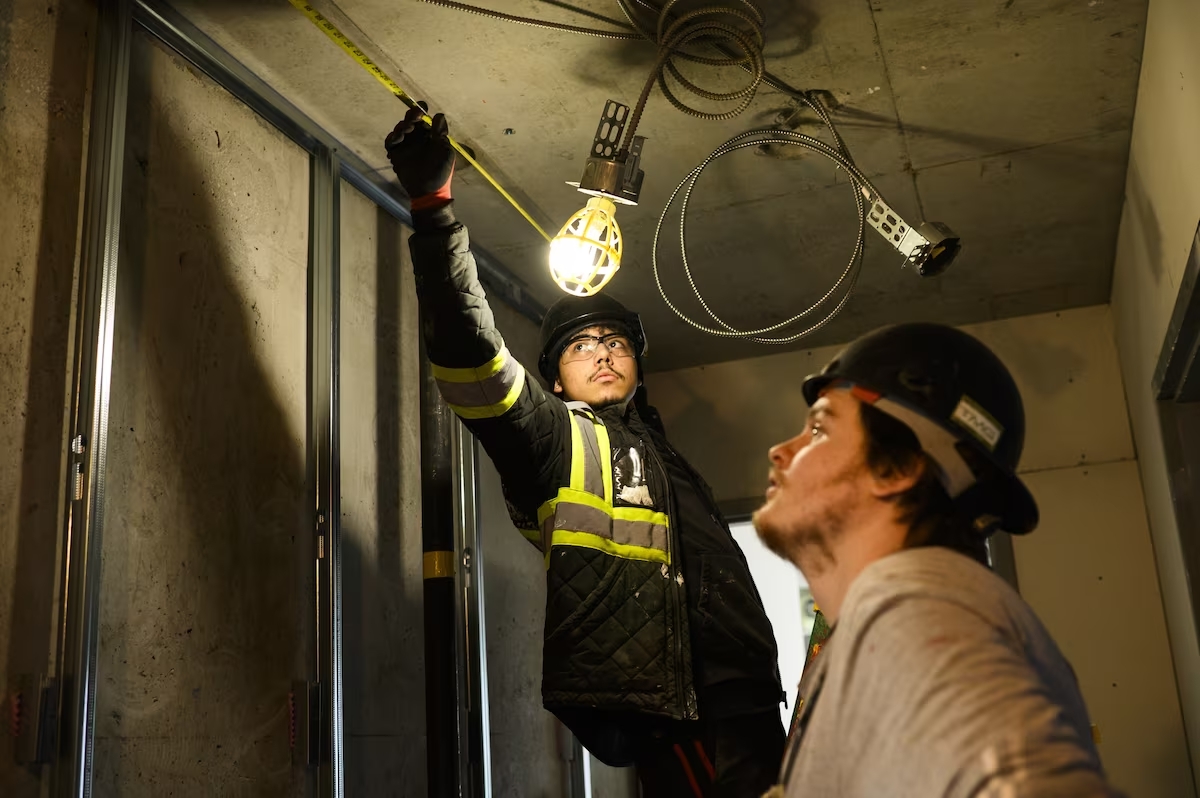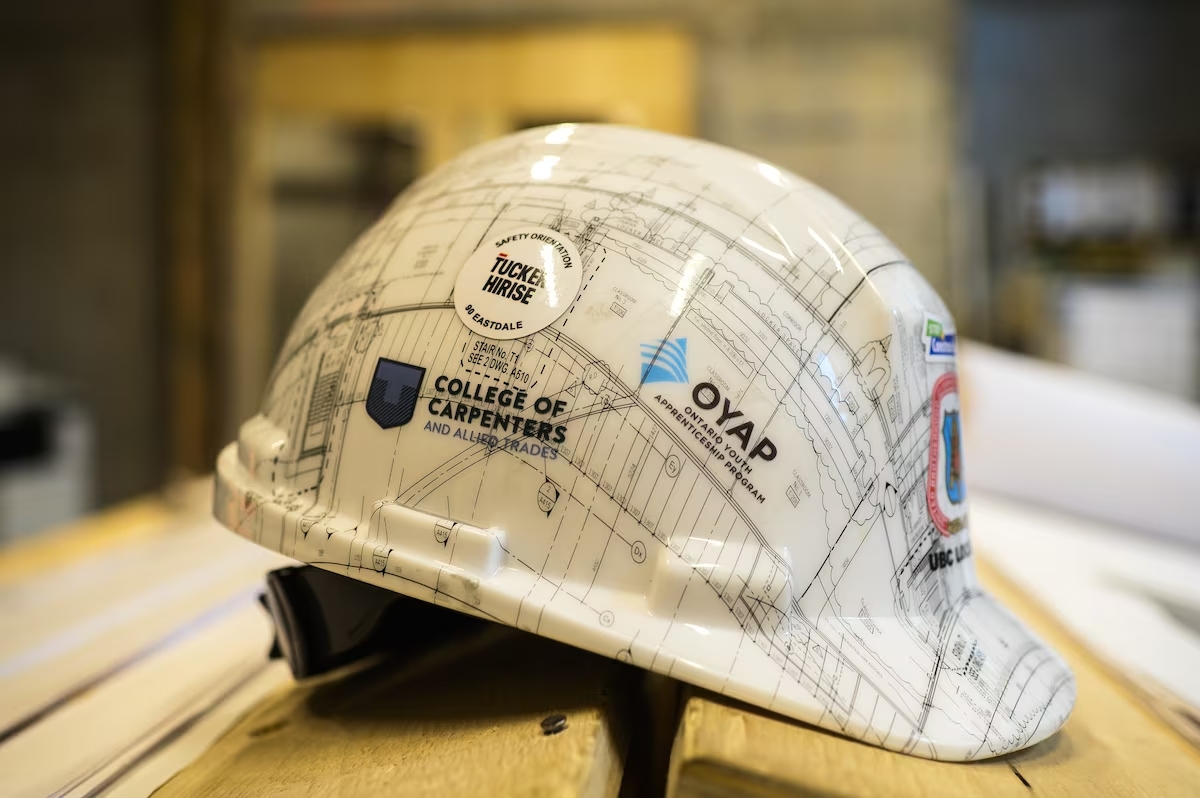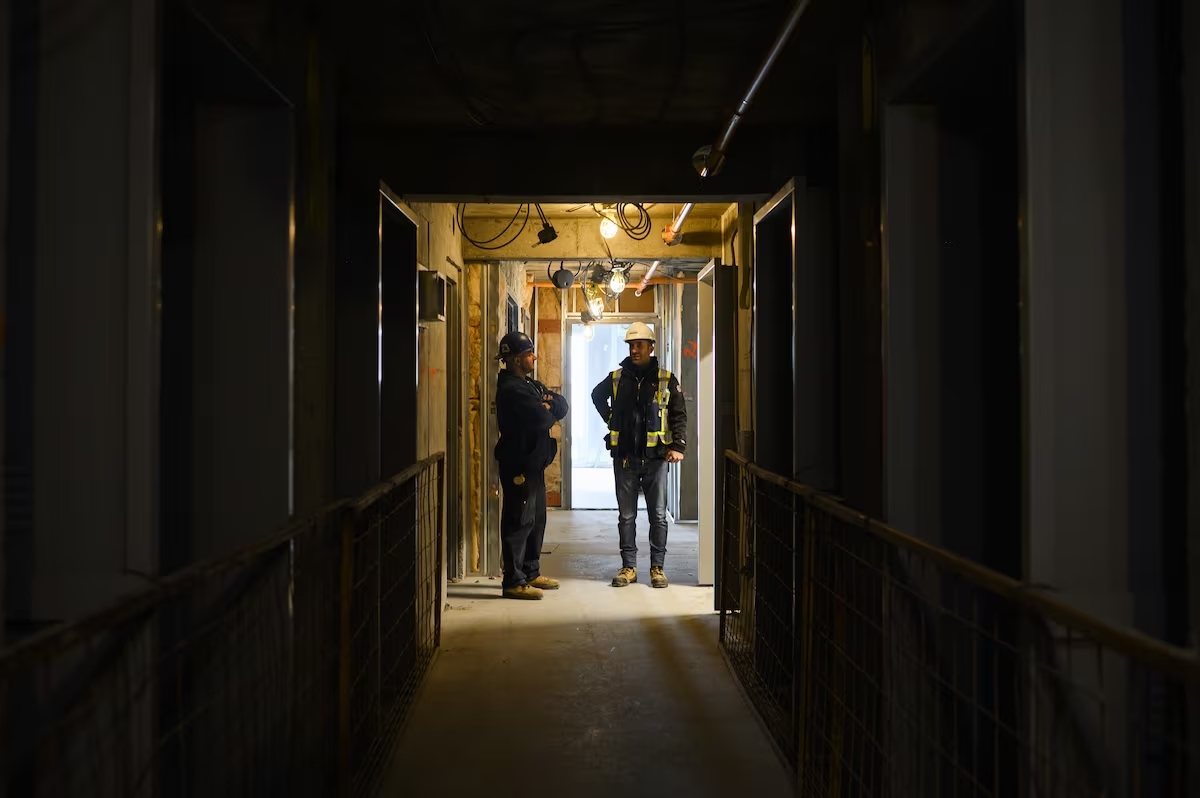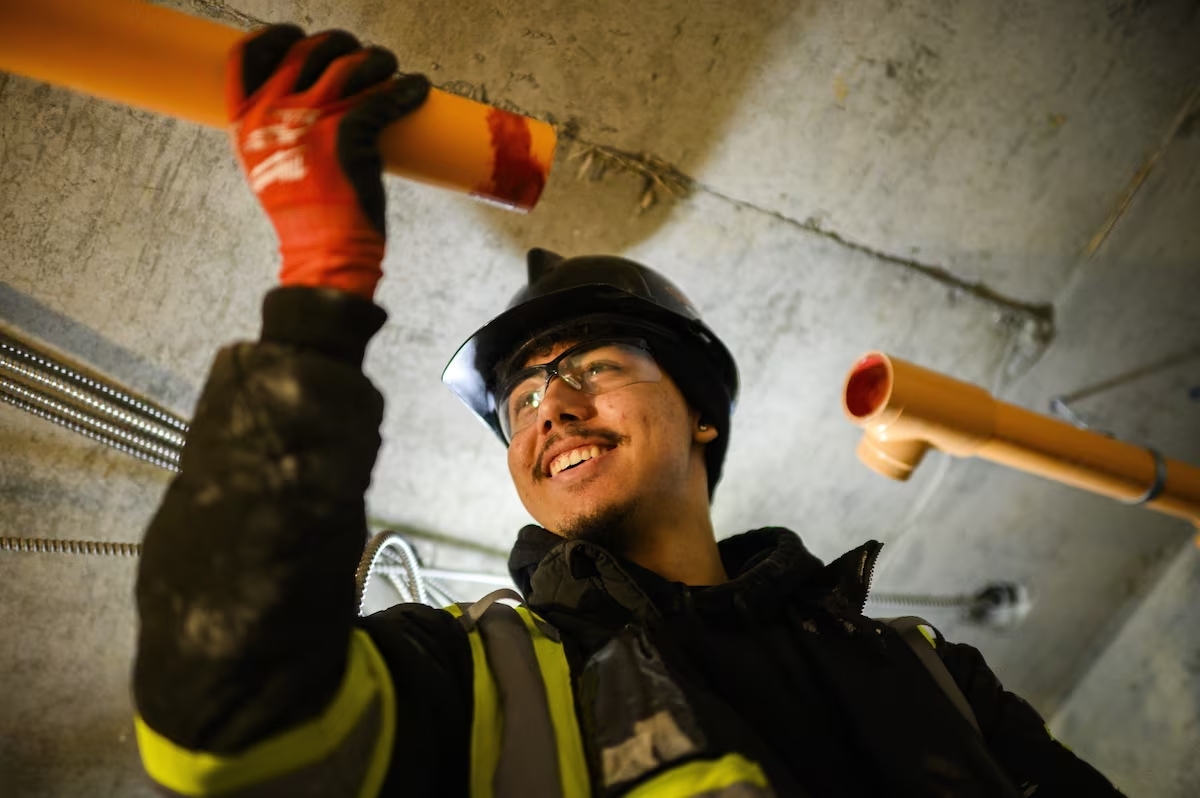As recruitment lags behind retirement in construction and other industries, educators are fighting old stigmas and offering different incentives.

High-school student Evandro Arruda fits a sprinkler pipe with advice from Neil Kelly, a fourth-year apprentice, at a downtown Toronto condo construction site. Mr. Arruda, 18, works at the site as part of the STEP to Construction program. CHRISTOPHER KATSAROV/THE GLOBE AND MAIL
Around noon on an unseasonably mild Friday in January, Evandro Arruda wasn’t preparing for his lunch period at John Polanyi Collegiate Institute, where he’s a senior. Instead, he was working 29 storeys above the ground, helping to install a sprinkler system in a new condo development in downtown Toronto – and he was much more in his element there than in the classroom.
“Feels good,” he said, perched on a ladder, a warm smile across his face. “For me, I like hands-on.”
Over the previous three months, he’d tried out several construction trades – a skilled-trades sampler, if you will – to give him a flavour of potential careers after completing high school. He’s either observed or worked alongside electricians, plumbers, drywallers, elevator mechanics, painters and now sprinkler fitters – opportunities that are all part of STEP to Construction, a Toronto District School Board semester-long program aimed at opening new career pathways for students.
In school, Mr. Arruda, 18, has been barely passing his subjects, and his attendance is equally poor. “It’s just not for me,” he said. “I feel like a robot. I wake up, go to school, do homework, just like everybody else. Repeat.”
But now, he’s excited to one day pursue work in a skilled trade. The same can’t be said for many others of his generation, for whom that path has become a tough sell – even as the trades in Canada face a severe labour shortage.
Canada ranks first among G7 nations for working-age people with college or university credentials, according to Statistics Canada. However, the number of new, young entrants into the skilled trades isn’t replacing those who are retiring quickly enough. In the construction industry alone, on a seasonally adjusted basis, employers were looking to fill 81,500 vacancies in the first quarter of 2022, up 7.1 per cent from the previous quarter, and more than double the number in 2020.
The decline in interest is mostly owing to the stigma attached to these types of jobs, which are often wrongly perceived as low-paying positions that lack long-term career prospects. But as demand for skilled-trade workers reached record high levels in 2021 and 2022, industry and government efforts across the country are attempting to dispel these myths and drum up interest among high-school students about to head into the work force.
In Canada, entering into what’s known as a compulsory trade – such as an electrician or a plumber – requires completing an apprenticeship program, which is a form of postsecondary education. The training combines paid on-the-job instruction under the supervision of a certified journeyperson and classroom learning at a college or union training centre. An apprenticeship can take as long as four years, and leads to a training credential or certificate. (Non-compulsory trades do not typically have the same requirements for certification.)
But provinces also have programs that encourage students to pursue an apprenticeship earlier, while they’re still working toward their high-school diploma. The New Brunswick Teen Apprenticeship Program, co-ordinated by the provincial government, allows students from Grades 10 to 12 to apply for paid summer employment and gain high-school graduation credits and apprenticeship hours toward a skilled-trade career after graduation. Program co-ordinators work with employers to determine student placements, but teens who have found their own employer can also connect to the program.
In British Columbia, the Ministry of Education and Child Care teamed up with SkilledTradesBC to run several programs, including one for which participants can receive credits toward their high-school diploma, and one level of technical training, by attending trades training classes at a local high school, postsecondary institution or certified training facility.
Ontario’s youth apprenticeship program allows students in Grades 11 and 12 to work in the trades through a co-operative education placement.
The province has also proposed to take the most radical step yet. The government announced last year that it would study whether it should allow students to leave high school after Grade 10 in order to transition to a full-time, skilled-trades apprenticeship program.
Students would be required to have a training agreement with an employer, and be working toward their certificate of apprenticeship. As part of this plan, the government is also looking at potentially lowering entry requirements for some of the 106 skilled trades that currently require a Grade 12-level education.
Raising the profile of the skilled trades in Ontario follows decades of focusing almost exclusively on opening doors to a university or college education. High-school students could choose from two separate tracks – one with more hands-on applied courses and the other more singularly academic – but the province announced in 2020 that it would phase out streaming, starting with Grade 9.
This was welcome news because evidence has shown that the streaming policy systematically disadvantaged marginalized students, Black students, Indigenous students and students from lower-income families. Observers noted that de-streaming provides all students more opportunities in a knowledge economy.
By the same token, students who prefer hands-on learning, such as Mr. Arruda, or who aren’t academically inclined, have often felt overlooked or not as supported.

Mr. Arruda and Mr. Kelly talk with foreman Andrew Cirillo at the construction site. CHRISTOPHER KATSAROV/THE GLOBE AND MAIL
Rick Hackett, a professor and Canada Research Chair at the DeGroote School of Business at McMaster University, was contracted two years ago to evaluate a trades boot camp funded by Ontario’s Ministry of Labour, Training and Skills Development. The program targeted high-school students and adults, with a focus on learning business skills, such as writing résumés, and working with tools in a simulated workstation overseen by a skilled-trades worker. Prof. Hackett found that exposing students to the trades, even through a boot camp, was an effective way to capture interest.
However, he noted that a major barrier to student participation in trades training is the influence of their parents, who want their kids to focus on white-collar positions. ”I believe that they attach a stigma to working in the trades, that professional degrees will provide their offspring greater lifetime prestige, income and social status,” he said. (His own son picked up a university degree and then attended college before joining a trade doing maintenance on airplanes.)
This single-minded push toward professional careers among Canadians stands in sharp contrast to the approach in countries such as Germany or Switzerland, which pride themselves on a dual-track educational model that puts trades on a much more equal footing. In Germany, young people can opt to enter a system that splits education between the workplace and classroom. Students apply for training contracts with employers, and, if accepted, they spend as many as three years training while receiving an education. Similarly, many Swiss students opt for an apprenticeship, which combines learning on the job – and being paid – with a couple of days a week at school.
In both cases, learning in the classroom doesn’t stop. What is unclear in Ontario’s proposal to create a pathway into the skilled trades after Grade 10 is how students would earn a high-school diploma.
The government is still consulting, and some critics warn that the province’s plan is short-sighted, worrying that kids will lose the longer-term benefits of analytical thinking and the exposure to different subjects that comes from staying in school.
“I personally don’t think this should be driven by a labour market problem. It should be driven by what’s important for students, and how can we more effectively prepare all students for all kinds of futures,” said Annie Kidder, executive director of People for Education, an Ontario advocacy group.
At the construction site in downtown Toronto where Mr. Arruda fastened sprinkler pipes in the hallways, other workers – electricians and painters – moved between apartments to complete their tasks. The project is just one of three condominiums Lanterra Developments is building within a 10-minute walk from the Eaton Centre.
Site superintendent John Fiacco described the struggle to find reliable and skilled tradespeople as more of his workers retire. He said he knows many parents want their children to attend university, but they should remember that there’s good-paying, steady work in the trades.
“People still need houses, people need places to live,” he said.
Mr. Arruda was the first high-school student Mr. Fiacco invited to one of his sites, and he’s been impressed with how well the young man listens and learns. He’s open to taking on more.
Programs such as the TDSB’s STEP to Construction – STEP stands for Specialized Trades Exploration Program – may be the key to deepening understanding of the skilled trades for both students and their parents.

TDSB teacher Elvy Moro had an idea that eventually brought STEP to Construction into being. CHRISTOPHER KATSAROV/THE GLOBE AND MAIL
Elvy Moro, one of the teachers leading the semester-long program, was initially inspired by a student in his co-operative education class at Northview Heights Secondary School who approached him about two decades ago wanting to be a bricklayer. Despite making multiple calls, Mr. Moro couldn’t land him a spot. Employers were reluctant to have a high-school student on a construction site.
“I must have made 30 calls,” he recalled, “and I couldn’t place him. I couldn’t give him the experience that he came to me for.”
Instead, Mr. Moro found the student an opportunity at a warehouse for pools and spas – after which the teen said he now wanted to try his hand at plumbing.
While struggling to find another co-op placement, Mr. Moro expressed his frustration to a friend in construction, who offered to expose the student to all the construction trades at one of his sites.
For Mr. Moro, that sparked an idea – and eventually the STEP to Construction program. Over the years, and over multiple phone calls, meetings and just walking over to construction sites, Mr. Moro convinced developers to give students an opportunity to try out different trades before they’d have to decide which to pursue.
Now, students from across the city apply to his program. He can only accept about 40 students, and in this current semester, he received more than 80 applications. He says interest has only been going up, and he’d like to expand the program so more students can be exposed to a variety of trades earlier.
One of the long-standing assumptions about the trades is that they’re back-breaking manual labour. They can be. But they also entail obtaining valuable technical expertise.
These days, many trades require a high level of computerization skills. Consider how much of a building is operated by a management system, which involves wiring and network programming. And electricians must now know how to program smart home systems.
Sheldon Anderson, dean of Lethbridge College’s Centre for Trades in Alberta, said one of the first tools an automotive mechanic needs is a laptop, which was not the case when he started in the trade decades ago. It’s used to check the engine codes and ensure the settings in the cars are working and that the software is up to date, he said. “You still need those basic things that never go away, like brakes and suspension, but it’s so much more.”
The college runs a similar sampler program to Mr. Moro’s, in which students in Grade 10 can spend some time on campus learning 11 different trades. One week, they change their own oil. Another week, they learn to change taps. While focusing on carpentry, they build a sawhorse that they then take home. By the last year of high school, Mr. Anderson hopes they’ve narrowed their focus.
On too many occasions he’s seen students enter an apprenticeship right out of school only to feel they’ve made the wrong choice. Indeed, fewer than 40 per cent of apprentices obtain their certificate after finishing a program, according to a research report prepared by People for Education. The group found several reasons for this, including a mismatch in expectations between employers and apprentices, and a lack of support and guidance to navigate the system.
“How many kids graduate now that have no idea and decide ‘I’m gonna do a gap year and figure out life’ or ‘I’m just gonna go take generals and rack up student loans without actually having direction,’” Mr. Anderson said. “But if we had more samplers, maybe they could decide sooner. And actually, if they could see what an accountant does, what a doctor does or what any of these trades do, I really think that you’d have less people wandering.”
That’s certainly been the case for Mr. Arruda.
An admittedly tardy student, he was punctual for his 7 a.m. start at the Toronto construction site. And he would have stayed well past his shift, if allowed. “Nobody wants to stay extra at school,” he joked.
The trades sampler was the push he needed to figure out his next steps. After high school, he plans to attend college with the goal of joining the elevator mechanics.
For now, though, it appears he may have more than one job to choose from. Mr. Arruda’s work ethic at the Lanterra Developments site was noted, and he’s already been offered a job with the sprinklers unit when he graduates.
CAROLINE ALPHONSO
EDUCATION REPORTER
The Globe and Mail, February 28, 2024



